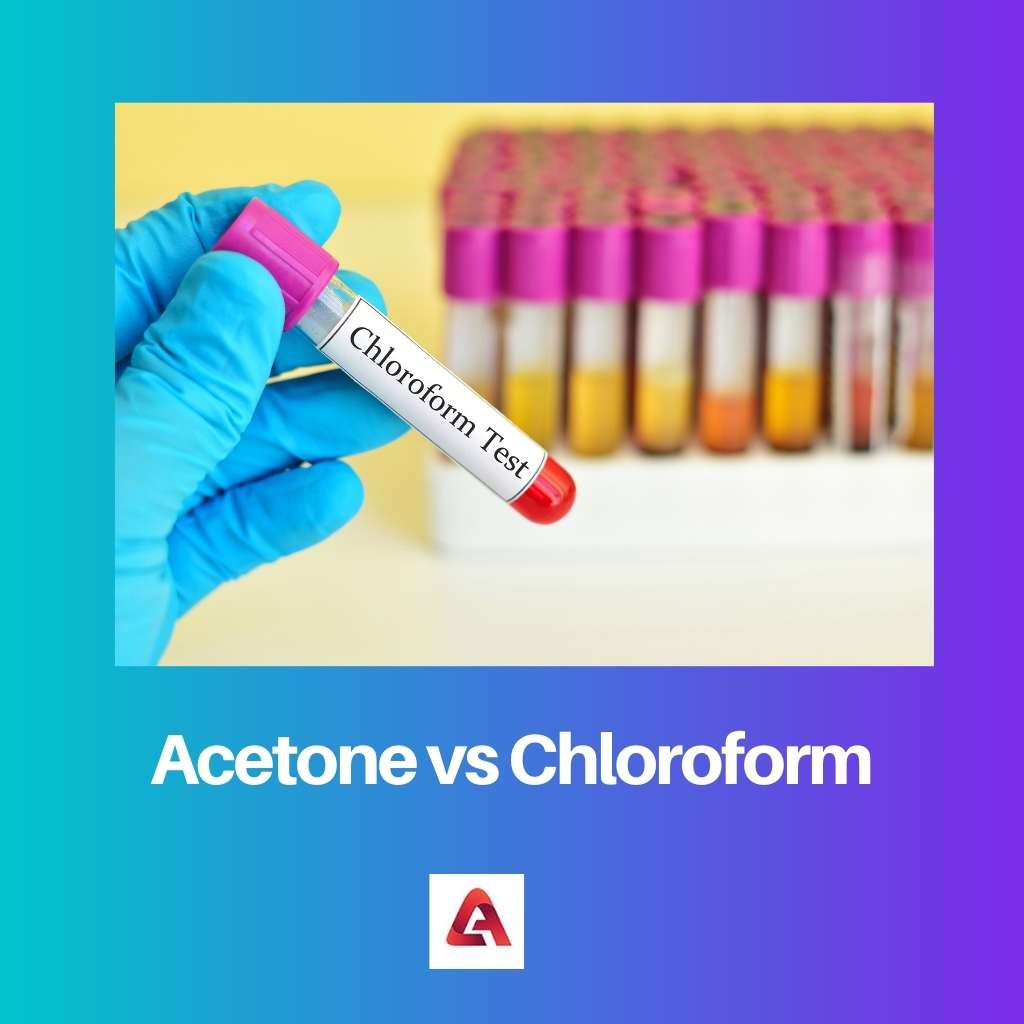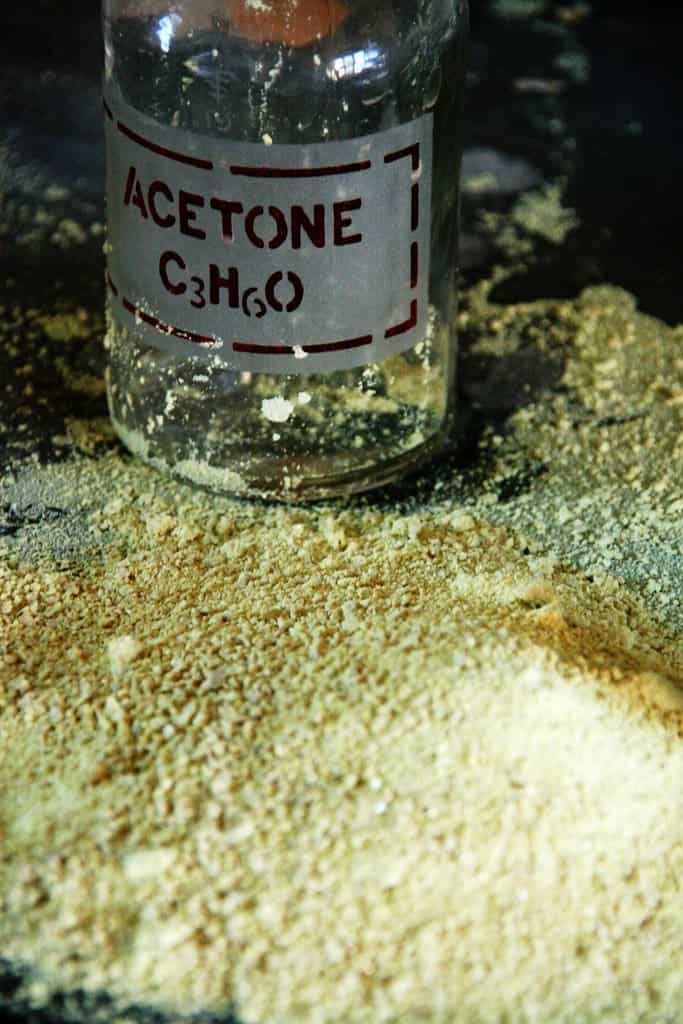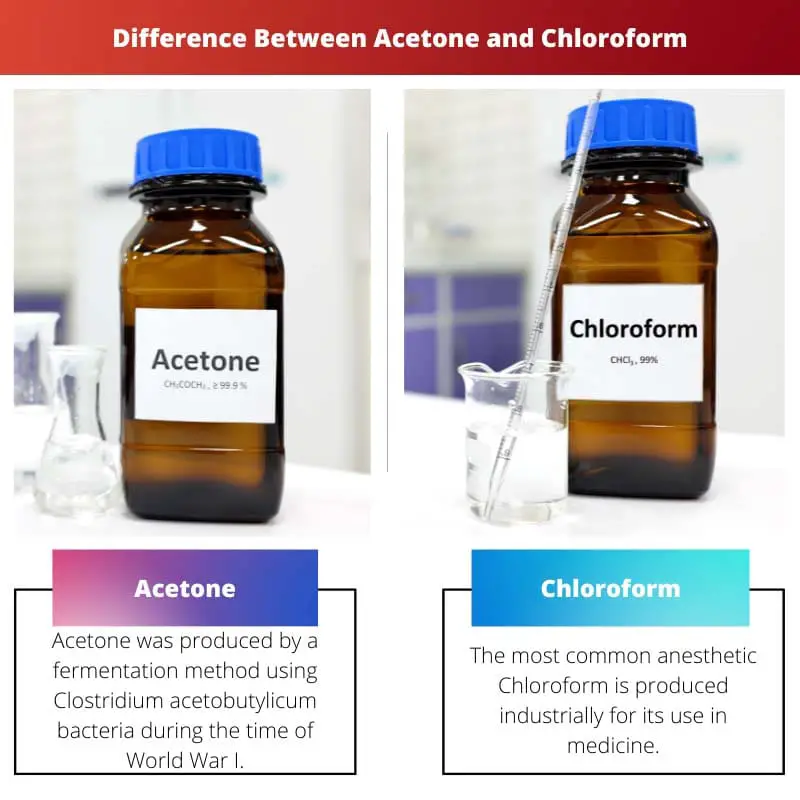Today’s world depends greatly on science and technology. For new inventions and to implement technology we need different materials.
Chemicals are indispensable for any innovations. They are used by people for almost every activity in daily life.
Different chemical compounds have different applications. Chemical compounds are classified among them into different categories based on their properties.
Key Takeaways
- Acetone is a colorless liquid commonly used as a solvent, while chloroform is a colorless, sweet-smelling liquid formerly used as an anesthetic.
- Acetone is more volatile and evaporates faster than chloroform, which is more stable and has a longer shelf life.
- Acetone is less toxic than chloroform and is commonly used in nail polish remover, while safer anesthetics in medical settings have largely replaced chloroform.
Acetone vs Chloroform
Acetone is used as a solvent and cleaning agent but can also cause skin irritation, eye irritation, and respiratory problems when used in high concentrations. Chloroform has been linked to potential health risks such as liver and kidney damage and cancer and is less used in industrial applications.

Acetone is a flammable organic compound. It gives off a pungent smell that is floral to cucumber-like.
It is produced in industry for its application as solvent. Andreas Libavius was the scientist who produced acetone for the first time in 1606.
A larger proportion of the industrial acetone produced is synthesized via the cumene process.
Chloroform is widely known for its medical use. It has a strong smell and is colorless.
It is an important component used in refrigeration. It gives a euphoric and sedative effect when taken in or inhaled.
Though it has good applications it is found to have carcinogenic and teratogenic effects. It is also produced by some fungi and seaweeds.
Comparison Table
| Parameters of Comparison | Acetone | Chloroform |
|---|---|---|
| Flammability | Inflammable so it must be handled carefully | Not inflammable |
| Formula | C3H6O | CHCl3 |
| Toxicity | It is less toxic and causes only skin and eye irritation when contacted | It is highly toxic and causes coma, jaundice, or other severe effects |
| Uses | As a solvent, Thinning paint and removing nail polish | Anesthetic, in Fire extinguishers and solvent |
| Natural sources | Produced in the body by ketosis | Fungi and seaweeds produce it. |
What is Acetone?
Acetone was produced by a fermentation method using Clostridium acetobutylicum bacteria during the time of World War I.
But with the identification of new and simpler methods like the cumene process, the older method was abandoned. Acetone is also produced in the human body at certain times.
People who are in a long fasting or special diets with low carbohydrates and high-fat content have increased amount of ketone bodies.
When ketones are high in the body ketosis occurs. This process causes the formation of acetone.
The major role of acetone in the industry is as a solvent. It is also used as varnish in painting.
In cosmetics, acetone has an important role as nail polish removers. It can also be used to clean paint from unwanted areas.
Paint thinners are essential for thinning and loosening paints. Acetone is used for this purpose. It is also used to clean laboratory equipment.
It is also a de-stainer that can be used on some type of stain. Acetone is also good for acne treatments since it is a good chemical exfoliator.
It is used in the defatting step of exfoliation.
Acetone is found to cause skin and eye irritation. It is not extremely hazardous like many other chemicals.
The high volatile nature of acetone makes it a compound with fewer environmental effects. Besides these functions acetone is also used in laboratories as a reagent for many experiments.

What is Chloroform?
The most common anesthetic Chloroform is produced industrially for its use in medicine. It is also produced by some type of fungi and seaweeds.
90 percentage of the chloroform in the atmosphere is released by natural sources. Both biotic and abiotic sources are responsible for the production of chloroform.
It is volatile and does not accumulate in aquatic organisms. Its volatile nature helps it to leave the soil and degrade in the air.
When bleaching powder is used to sanitize the common household mixes with compounds like ethanol and acetone they produce a small amount of chloroform. But in industry, it is produced by mixing methane with chlorine.
Chloroform is also used as a solvent for oils, rubber, resins, and wax. It is used in fire extinguishers. Chloroform is used as a solvent for NMR spectroscopy.
Chloroform was used for surgical procedures in the 1850s in the UK. It gained a great reach as an anesthetic.
But, its toxicity was identified as then its usage was limited. Now many other choices are available and the use of chloroform has become very limited in the medical field.
It was experimentally proved in 1911 that chloroform induces cardiac fibrillation. It is also illegally used by criminals to knock out their victims.
Since it is formed as a result of bleaching powder reacting with other compounds it is commonly found in chlorinated tap waters.
Chloroform caused severe medical conditions like jaundice and coma in humans exposed to high amounts of Chloroform.

Main Differences Between Acetone and Chloroform
- The main role of acetone is in Nail polish remover and as paint thinners. But, Chloroform has an important role as an anesthetic
- Acetone is not carcinogenic or teratogenic whereas, chloroform is toxic and has carcinogenic and teratogenic effects
- Acetone is formed in the body of people that are fasting and takes a diet rich in fat and low in carbohydrates while chloroform is naturally produced by some organisms
- Acetone is considered a compound with no adverse side effects but chloroform can cause jaundice, coma, or liver damage
- Acne treatments that come with exfoliation sometimes involve Acetone. Chloroform is crucial in spectroscopy and Chromatography.

- https://www.tandfonline.com/doi/abs/10.1080/00268979400101331
- https://agupubs.onlinelibrary.wiley.com/doi/abs/10.1029/93JD00764

The comparison table provided in the article is particularly helpful in understanding the key differences between acetone and chloroform.
This post is very informative and it has an extensive information about chemicals and their uses. This is a very educational post.
I agree with you Clarke. The post is really loaded with information about two important and widely used chemicals.
This post is overly dense with unnecessary scientific details and seems redundant.
This is a really in-depth article on the comparison between acetone and chloroform. It’s important to understand the distinction between the two.
I found it very interesting and educational to learn about the contrasting properties and applications of acetone and chloroform. Great read.
I agree. The article provides a great overview of the uses, production, and effects of these chemicals.
I’m not sure about the relevance of this information in my daily life. It seems too technical and specific for general knowledge.
While you may not use this information every day, understanding the properties and differences between these chemicals can be important in contexts like safety and health.
I appreciate the thoroughness and depth of this article in its discussion of the production and applications of acetone and chloroform.